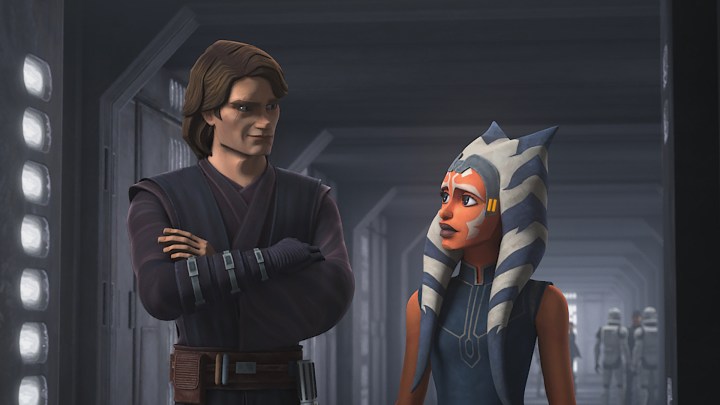
“Star Wars: Tales of the Jedi is more Clone Wars comfort food that expands upon fan-favorite characters, but offers little that we haven't seen already.”
- Dooku's character arc is well-executed
- The animation style is further refined
- Ahsoka's origin is excellent
- The pacing is disjointed
- The storylines are too familiar
- A missed opportunity to feature more Jedi
As Andor pushes Star Wars to new levels of thematic nuance, narrative maturity, and production value, some fans have taken its success as an opportunity to deride the other Star Wars stories around it. To an extent, that’s understandable, as the gulf of quality between Andor and, say, The Book of Boba Fett, is fairly large. Nonetheless, success in this universe takes many shapes, and Tales of the Jedi is part of a longstanding, successful Star Wars tradition that stands alongside live-action works: animation.
Live-action narratives in the galaxy far, far away have always set the tenor for the franchise. However, dedicated fans know that truly rich storytelling often exists in animation. Genndy Tartakovsky’s Clone Wars (2003) miniseries evoked a sense of artistic grandeur and mythology that the franchise has never recaptured, save perhaps for the anime anthology series Visions. These two shows are some of the best, most imaginative pieces of Star Wars media ever. While Tales of the Jedi has moments of excellence, the sum of its parts settles for being an alright, albeit overly familiar, Star Wars experience.
Meeting the standards of modern Star Wars animation

Star Wars: Tales of the Jedi is just the latest in a long line of animated projects that truly hit their stride in the time between Revenge of the Sith and The Force Awakens. The most famous animated series are certainly those associated with Dave Filoni: The Clone Wars (2008) and Rebels. Both nestle neatly into the core Skywalker Saga, filling in the gaps around the original and prequel trilogy films. For as much as they serve to support the movies, though, they also seek to widen our view of two galaxy-defining conflicts. Each is absolutely worth watching, but Rebels is arguably stronger, continuing the traditions and techniques from The Clone Wars with a tighter runtime and more thoughtful narrative arcs.
Nevertheless, The Clone Wars is certainly the more popular show. Its fanbase is vast, and Disney+ has been particularly kind to it, dropping ostensibly four more seasons of the series: the proper, final Clone Wars season, two seasons of The Bad Batch, and now Tales of the Jedi. Understanding this context is critical to understanding both Tales’ strengths and weaknesses.
Star Wars: Tales of the Jedi has the pacing and scope of Clone Wars (2003) or Visions. Its six-episode format leaves no time for the filler that bogged down the long-form animated shows, including the oddly bloated Disney+ season of The Clone Wars. Each episode has a defined purpose, principally exploring the rise of Ahsoka Tano and the corruption of then-Jedi Master Dooku. These also benefit from an animation team well-versed in its house style, which makes the show looks great.
However, almost all the episodes feel encumbered by the knowledge that The Clone Wars is perhaps the most universally-praised Star Wars media since the original trilogy. The result of this knowledge is a string of vignettes that fall into a very familiar trap: an over-reliance on fan service.

As such, Tales of the Jedi is easy to recommend to anyone who already enjoys The Clone Wars, but that’s not an emphatic recommendation. What made the previous animated shows so effective was how they found an interesting balance between expanding previously-established lore and building on top of it. Tales of the Jedi walks so closely alongside both the previous shows and films that little here feels inventive; instead, the show feels like a compilation of deleted scenes to slot in around stories we already love.
Revisiting Clone Wars favorites, for better and worse
The three episodes centralized around Ahsoka feel particularly tired. She’s one of the franchise’s best characters, but she’s also been featured across The Clone Wars, Rebels, The Mandalorian, and now an upcoming show of her own. Aside from the excellent starting episode detailing her youth, which hits all the right notes of Force-sensitive spiritualism, it feels like we learn little new about Ahsoka. There are some wonderful moments in her final episode (which will go unspoiled here), but even those circle ideas that we just explored in Obi-Wan Kenobi.

Exploring Dooku’s turn to the Dark Side is markedly more compelling. Dave Filoni shows us lore and character elements that have only been alluded to in television or film through asides in dialog or off-hand references. Like the best episodes of The Clone Wars, the stories that chronicle his growing skepticism surrounding the Jedi Order reveal new truths about the character in the context of totally original scenarios. Episode 2, “Justice,” and episode 3, “Choices,” are especially strong in this regard. Each presents a contained story with a visually-distinct backdrop that succeeds in narrative and theme.
Dooku’s final episode becomes a bit too constricting in how tightly it wraps around the plot beats of The Phantom Menace, but it nonetheless allows for moments of emotional reflection that deepen the Count. Although, its pacing feels a bit stilted, which is a problem across the entire series. Each vignette’s ability to feel cohesive and complete in roughly 10 to 15 minutes is variable. Some do work well with their truncated runtime. Episode 5, “Practice Makes Perfect,” though, feels more like a chapter from an Expanded Universe book rather than a short story with a satisfying beginning, middle, and end.
What could’ve been
It’s difficult to not want more from this series. This could’ve been a wonderful opportunity to explore six different Jedi Knights across the six episodes, perhaps offering only two that followed these fan-favorite characters. Star Wars animation offers the rare opportunity to go wild with fantasy scenarios that would be deeply impractical in live action, and here we could’ve seen alien Jedi on sprawling battlefields that’ll never appear on the silver screen. That’s what both Clone Wars series focused on so often. In Tales of the Jedi, though, we just get a lot of moments that feel as though they could’ve been slotted into Kenobi as flashbacks or into the upcoming Ahsoka show.

Ultimately, though, some of these criticisms may be railing against Tales of the Jedi’s central intent. Its goal, from the outset, was to offer more of The Clone Wars. That is exactly what it provides. And, despite a lack of ambition in the storytelling, the show still does manage to curate moments that further our favorite characters’ emotional development and backstories. Plus, it’s hard to resist seeing Anakin and Ahsoka together again, even if we have countless hours of that already. Just being back in this pocket of the universe feels nice.
At the moment, the anthology seemingly covers a lot of ground. We watch Ahsoka grow up, and we see Dooku reject his past. Upon reflection, though, it often feels like we’re covering very little. With rare exceptions, all we see are extensions of moments and character traits defined elsewhere. The Clone Wars and Rebels proved that you don’t have to visit a new era to tell rich stories which expand the universe, all the while keeping one foot on the fan service pedal. Tales of the Jedi has one foot on that pedal too, but it has the other foot on the brake.
Star Wars: Tales of the Jedi‘s six episodes are now streaming on Disney+.



